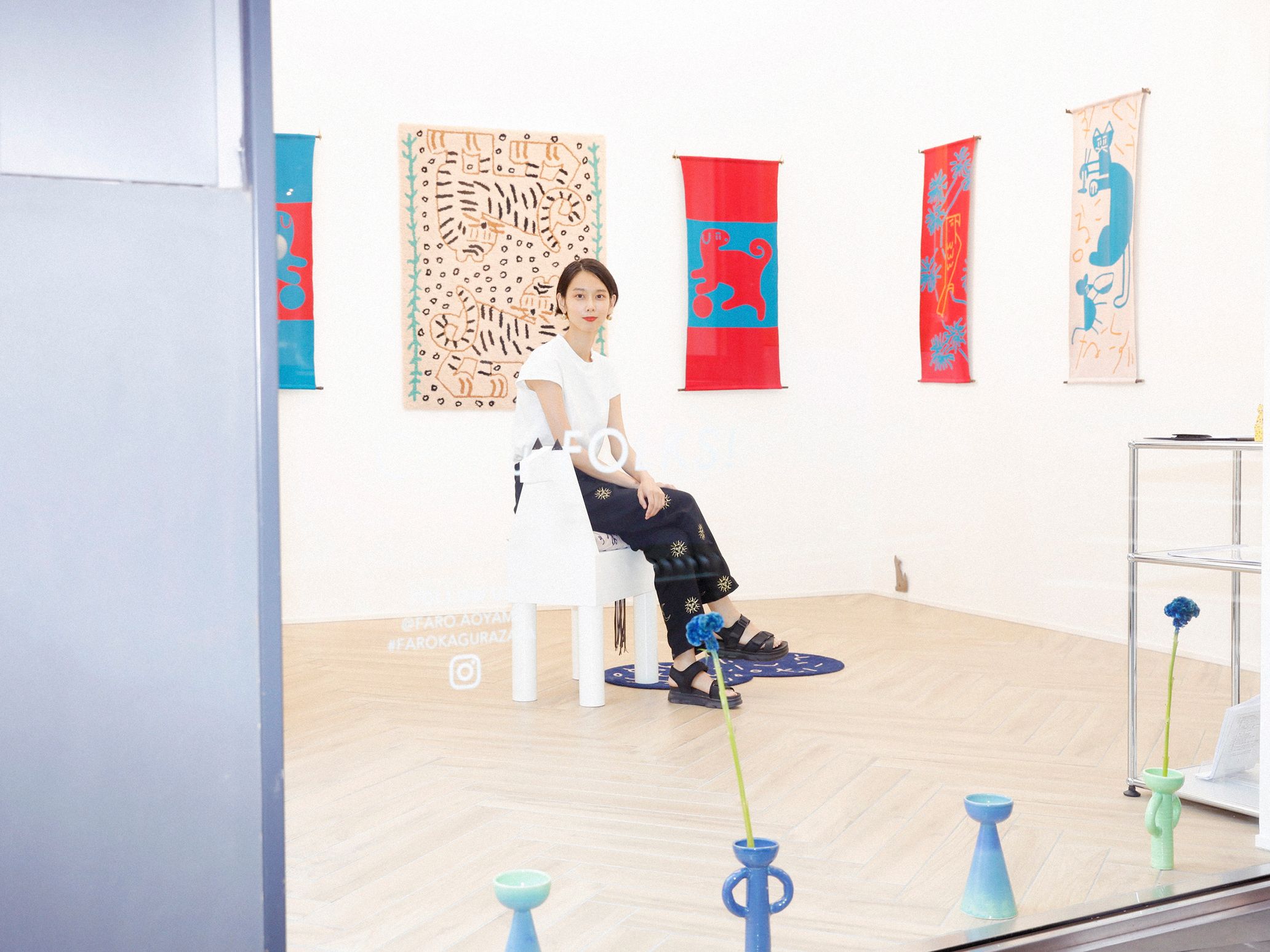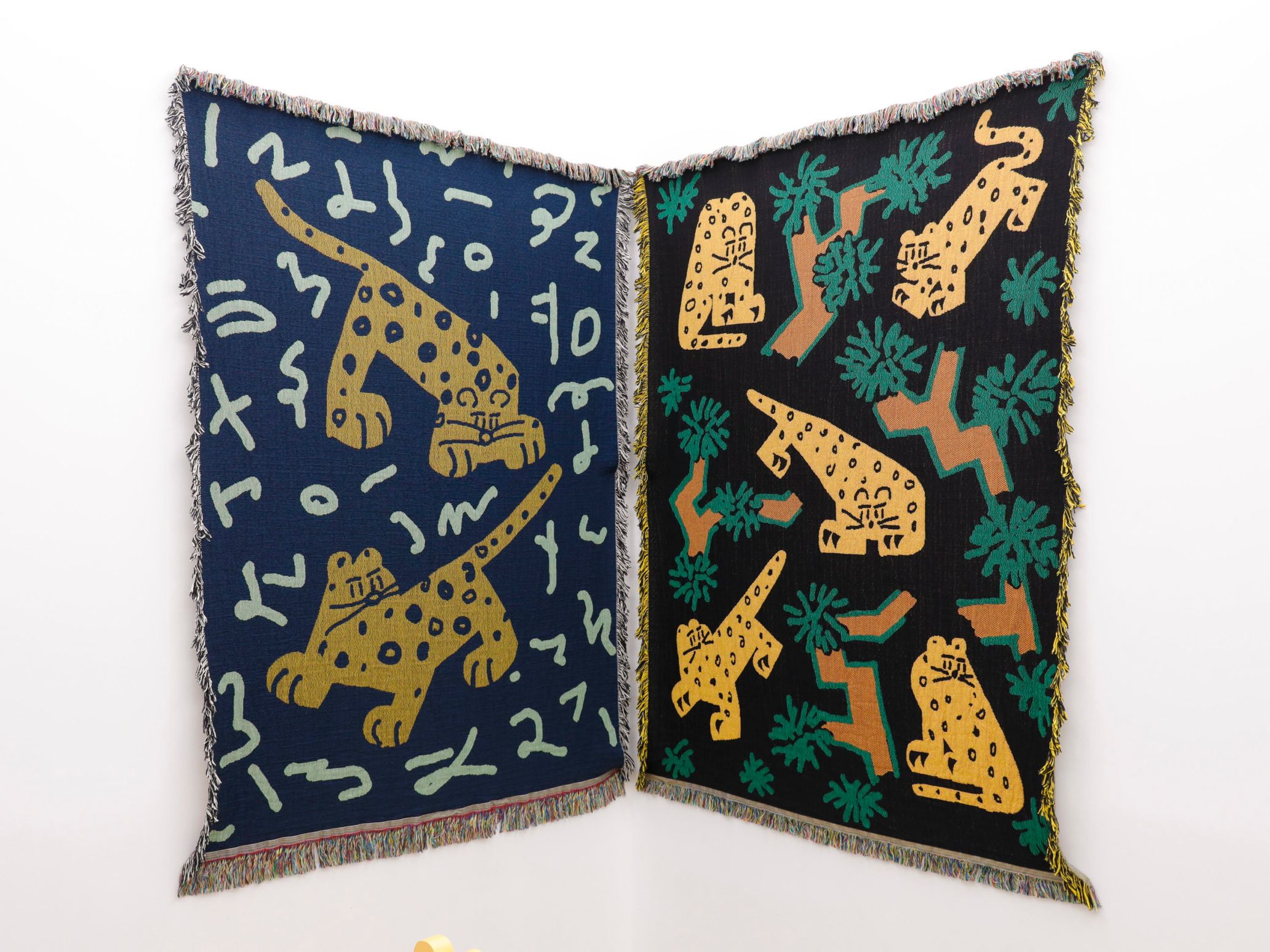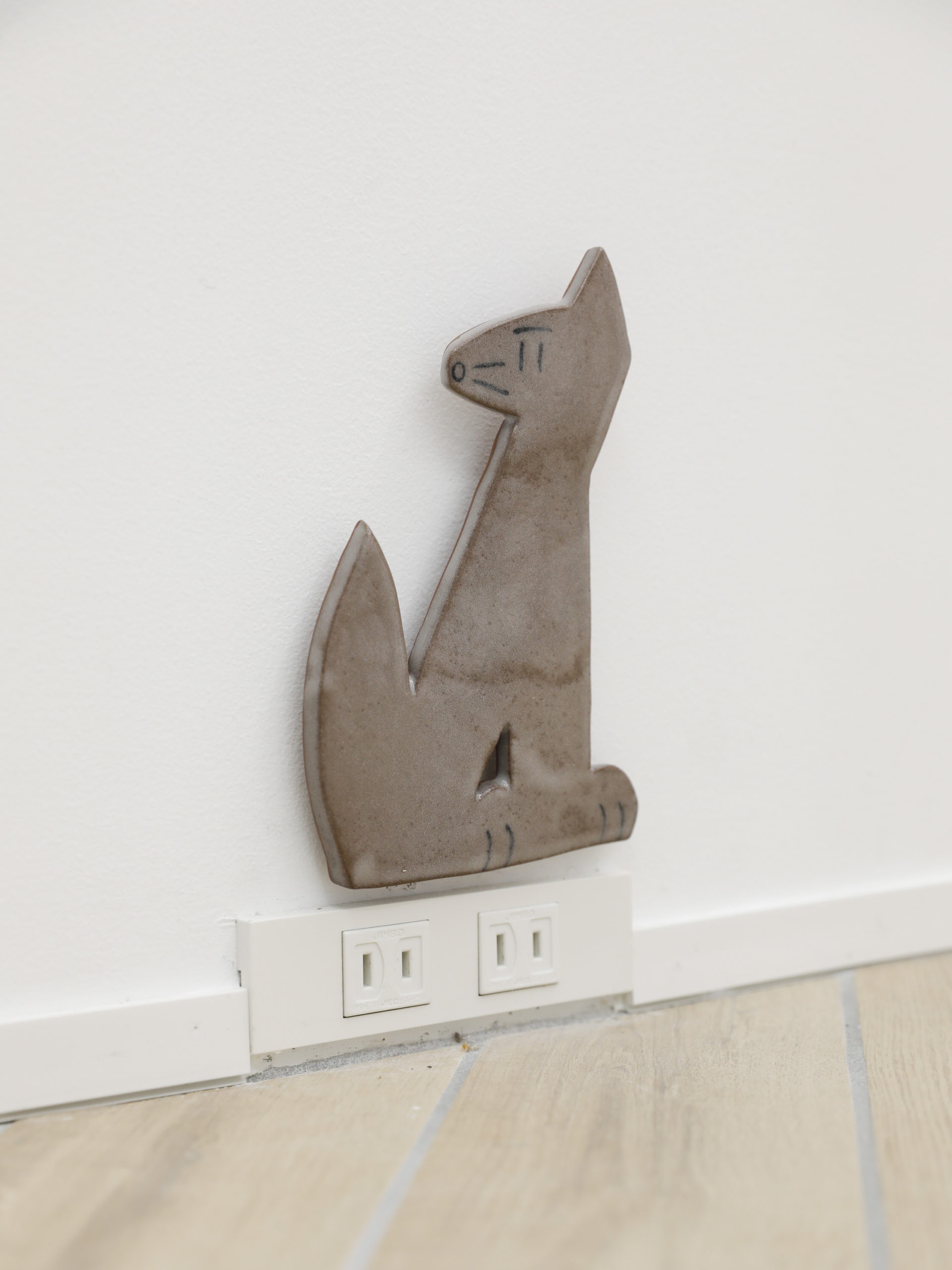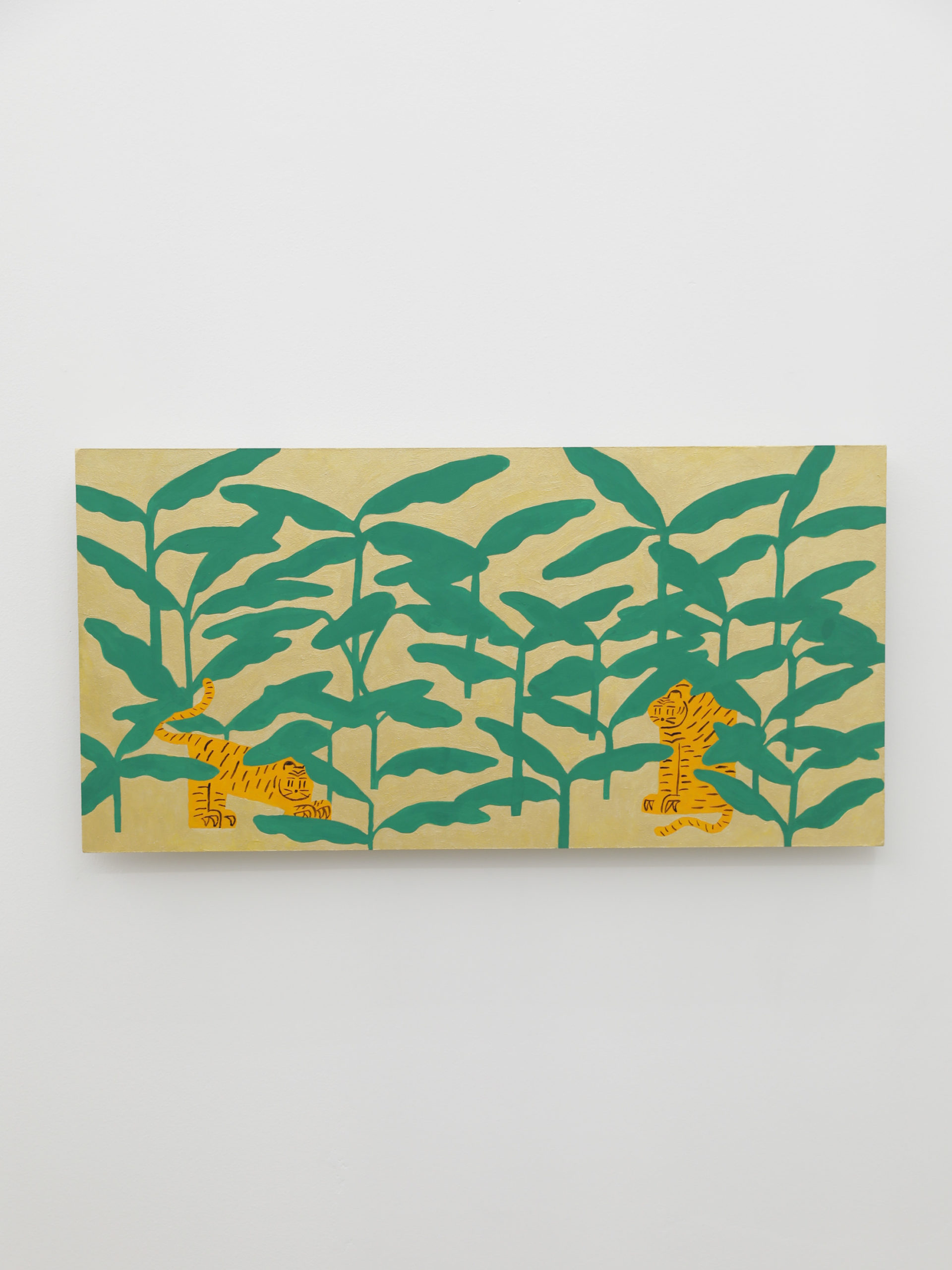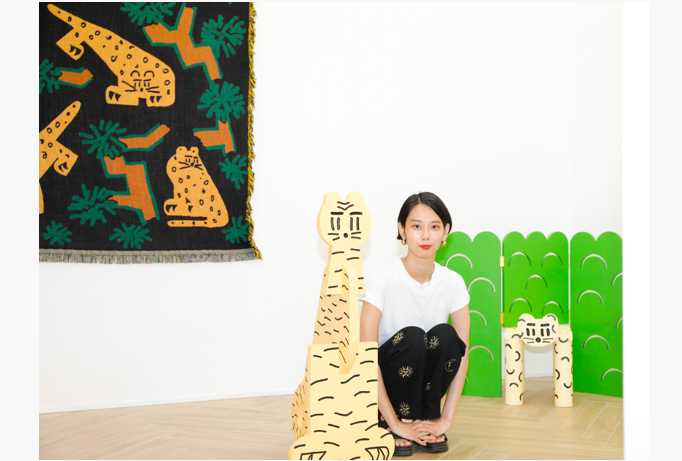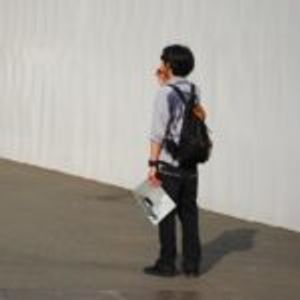Colliu is active as a model mainly for women’s magazines. But there is also a different side of her as an artist who creates artworks using various different expressive techniques that include level surfaces, three-dimensional objects, installations, and more. Recently she has not only been holding exhibitions in galleries, but has also been active across a wide spectrum that includes a public art piece in Miyashita Park, collaborations with brands, and more. She maintains an awareness of the “relationship between the viewer and the piece” with her creations. So now with her solo exhibition “FOLKS!” currently on display, we asked her about her philosophy when it comes to creating pieces that are conscious of distance, her solo exhibition being held during the coronavirus pandemic, and striking a balance between being a model and artist.
Creating spaces where the viewer is considered the star of the show
――What sorts of activities are you engaged in?
Colliu: When I originally create a piece, I maintain an awareness of the relationship between the viewer and the piece, with this solo exhibition being no exception. With this approach, the viewer should not just see the pieces, but should also be freer to come into contact with them. So in addition to the messages and concepts ensconced within the pieces, so to speak, we must also consider how the environment conveys these to the viewer. It is the viewer who is the star of the show through and through, and so I place importance on how they relate in terms of how they interact positively with the piece right before them.
With “Dear My Plinth” a solo exhibition I held last year, I took on the challenge of trying to control space by using pedestals. The exhibition space was rendered entirely in pure white, and I made pedestals to display the pieces that were colorful and came in all different shapes, then I miniaturized the pieces themselves. In addition, for “Prospect-Refuge” in which I displayed pieces in the restrooms at Laforet Harajuku, I created pieces based on the space. The atmosphere is different in every space expressing artworks, and so I give thought to how I can create something by making full use of the area and constraints of a certain location. Because of this, for my pieces I alter the expressive techniques for my pieces to suit the space, such as by employing level surfaces or three-dimensional objects.
――What is the difference in the mental approach you take to your creative activities and your client work?
Colliu: There is no difference internally within me. Despite the fact that there are tons of constraints with client work, I value the uniquely personal qualities found within it and give consideration to this based on the limitations with the display space when I am creating a piece. More than anything, I want the people who view my pieces to come away with a positive feeling, and I imbue both types of work with this same sentiment.
――Specifically, how do you go about creating spaces?
Colliu: First, I use a PC to create a 3D space, and proceed by performing simulations of where I should situate pieces and what size they should be. Previously, I used to actually create miniature spaces at a 1/6 scale. Doing this lets me physically instantiate the vision depicted inside my own head, and also makes it easier to convey this to the client.
――What was the impetus that led you to arrive at this approach to creating pieces?
Colliu: It started with the public art piece I did for Miyashita Park. With this I decided on the size and colors while looking at a 3D view of the actual park space. While there were various constraints and limitations, creating a permanent public art piece is something that I had always wanted to do, and so I really enjoyed it. By the way, out of a desire to make it a new monument for Shibuya, and have it serve as a symbol right after the Hachiko statue, I went with a three-dimensional artwork of a dog I call “Kyu-chan” Incidentally, I struck upon the name “Kyu-chan” because the “Miya” in “Miyashita Park” can also be read as “Kyu” I’d like to take on the challenge of doing more public art pieces in the future, and want to create objects that people can play with such as by touching them or sitting on them. On this point of “usability” in particular, this shares commonalities with my current solo exhibition “FOLKS!” that is based on the theme of folk art.
Originality borne from imbuing the “eyes” with personality
――So then let me ask you about your solo exhibition. Why did you decide to base it on the theme of folk art (popular art in which artworks are adorned with the daily items people keep all around them to make everyday life more fun)?
Colliu: The inspiration for this came when I encountered folk paintings from Korea from the Joseon Dynasty era during my ordinary creative activities. While I was researching this, I learned that these folk paintings from Korea were created by envisioning the daily life of the owner of the piece. I got the feeling that this was similar to my own creations. So my desire to put on a solo exhibition via folk art led to this current exhibition. Up until now, I had faced high hurdles in using animals as motifs, but creating Kyu-chan for Miyashita Park made me really start to enjoy creating animal motifs. To the point that with this current solo exhibition there are almost no human motifs. This is my new challenge. Since I inherently want my pieces to liven up the viewer in a positive manner, I realized that there was no need for me to be fixated on the human form. More than anything else, I want my pieces to make people aware that they are viewing one of my works based on the “eyes,” and this is true whether the motifs are people or animals.
――Definitely. This time around animals are the main motif, and there are lots of tigers. The animals’ eyes are one of your defining characteristics, as they have a zigzag pattern.
Colliu: Yeah, that’s right. The folk paintings from Korea from the Joseon Dynasty era that attracted me were jyakkozu, or pictures of tigers. These were created in order to decorate indoor spaces while retaining the significance of a magical talisman or token of good luck, and come in a wide variety of different types. So for my own solo exhibition I incorporated tigers and komainu (the stone lions at the entrances to shrines and temples) into objects found throughout our ordinary, everyday lives such as carpets, mats, and chairs. What I focus on with eyes is that the eyes are an iconic element when it comes to establishing a person’s identity. So this got me thinking that if I could impart the eyes with originality, I could make any piece uniquely my own.
――Incidentally, are you changing how you portray eyes?
Colliu: I’ve gradually gone about simplifying them. Initially I was inspired by the highlights around eyes in manga comics, and would add lightning bolts inside the eyes. But over the course of sketching these I made them limp and soft, to the point that now I make them like lines and so any lingering remnants of eyes have disappeared completely (laughs).
――At the same time, you also work as a model. Are there any changes in your mentality that come about from switching between viewing a subject and being viewed as one?
Colliu: I began working as a model before I became an artist. Models are required to have objectivity, and I bring this objectivity to bear in my activities as an artist as well. In addition, the trends and social information I pick up on and acquire through my work as a model serve as important elements for me. I sometimes get asked which one is my primary occupation, but I think of my existence as Colliu as a combination of model and artist, with both of these being indispensable.
――Lastly, do you have a message for the people looking forward to your solo exhibition?
Colliu: Through my artwork I want to cheer people up. How people feel about them will vary depending on the viewer, but if people’s mood were to somehow lighten up and they were to grow cheerful without being overly aware it was because of the piece, then that would make me happy. Also, I imagine that there will be a lot of people who decide not to come because of the coronavirus pandemic. So I’ve arranged it so that people can enjoy this solo exhibition in a 3D space online as well. I invite everyone to enjoy it, whether in real life or virtually.
Colliu
Born in Yokohama City, Kanagawa Prefecture. Artist and a model. Began working as a model while still enrolled as a student at Musashino Art University, before later starting her activities as an artist. Covers a wide range as an artist, including everything from drawing to three-dimensional objects, spaces, and installation pieces. The public art piece of a dog located at the entrance to Miyashita Park in Shibuya was done by her.
http://colliu.com/
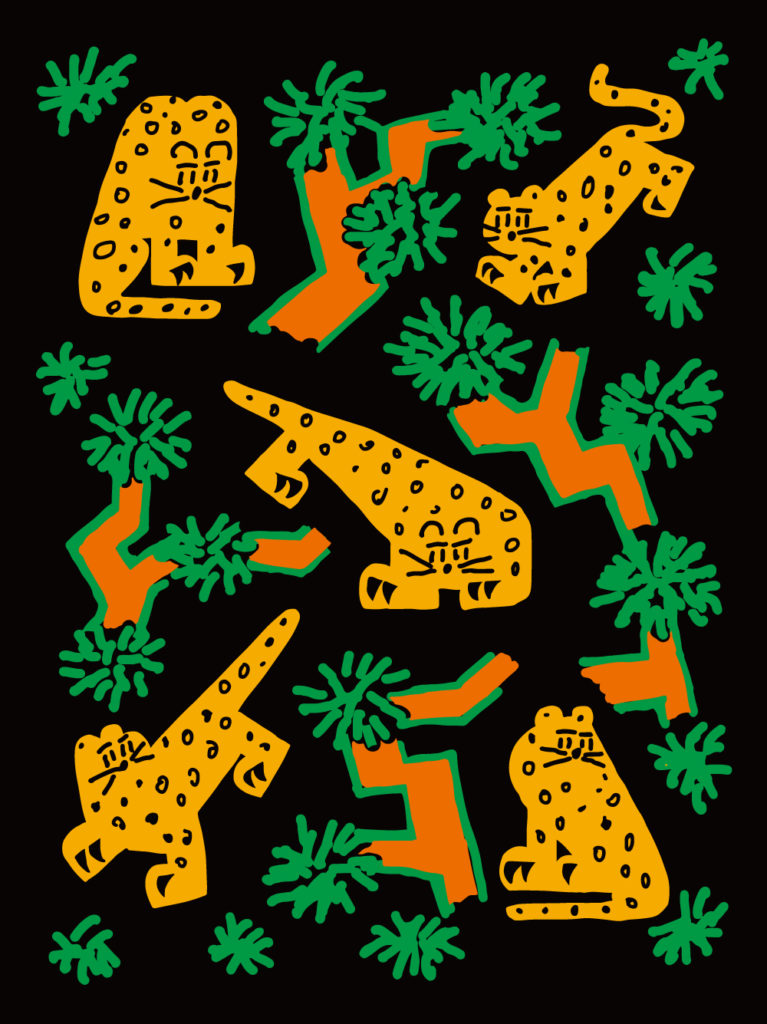
■Colliu Solo Exhibition「FOLKS!」
Date:~ September 5
Venue:FARO Kagurazaka, Tokyo
Time:13:00~19:00
Closed:August 23, 24, 30, 31
3D Online:http://colliu.com/post/exhibition/1999/
http://faroaoyama.com/gallery/2731
※Entry restrictions may be imposed when the gallery is crowded.
©Colliu
Photography Shinpo Kimura

